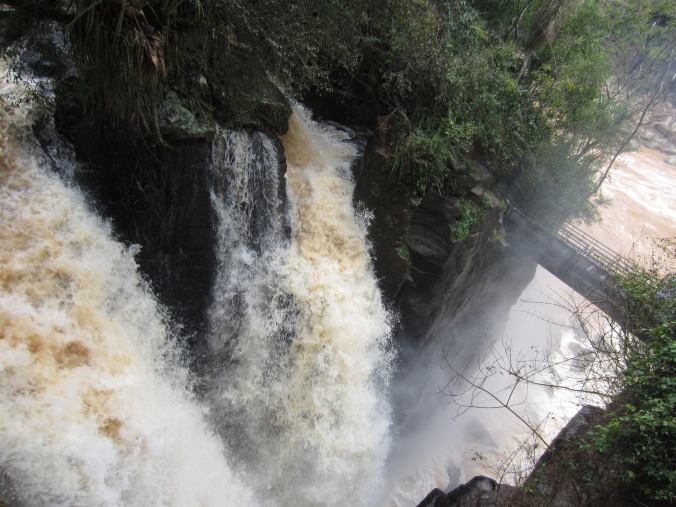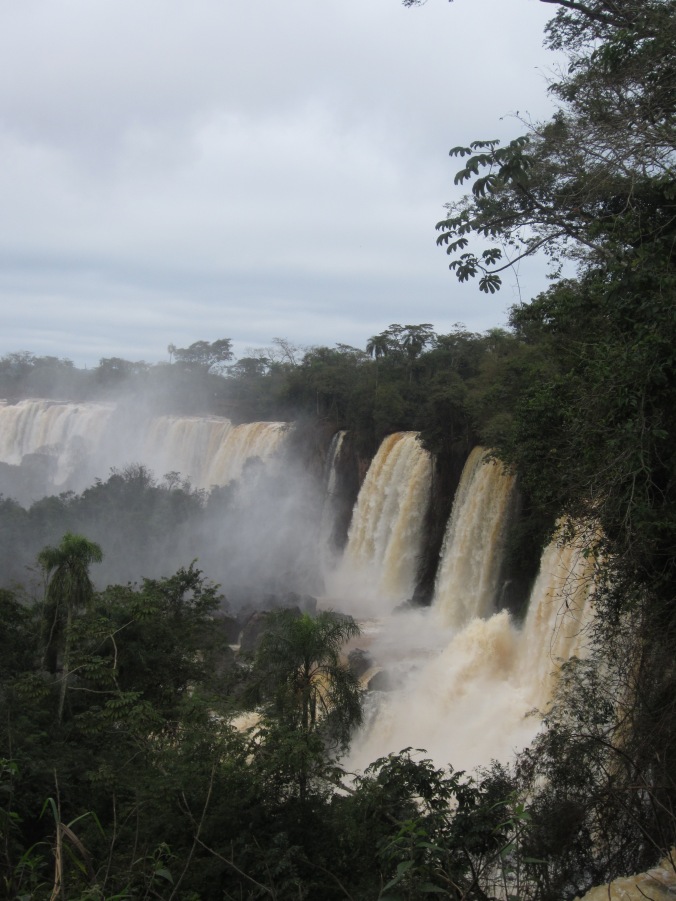Sorry for the lack of an update yesterday; I was pretty sleepy and words were… somewhat challenging. So! Let me catch you all up on yesterday and today’s adventures.
We did in fact wake up at four in the morning yesterday, as planned, and it was just as unpleasant as you might think it would be– especially as it was cold and damp and pitch black. One of my favorite poets, Wislawa Szymborska, has a rather brilliant poem about how awful 4:00 AM is. She writes that:
No one feels fine at four a.m.
If ants feel fine at four a.m.,
we’re happy for the ants. And let five a.m. come
if we’ve got to go on living.
Yep.
So there we were, on the side of the road in the Middle of Nowhere, Paraguay, at 4:30 AM under one of the few working streetlights, listening to the local roosters try to out-crow one another. This was because the bus to San Estanislao usually comes between 4:45 and 5:30, and we didn’t want to miss it. Em and I spent our time watching headlights approach and straining to see if the lights belonged to a bus, blowing smoke rings of condensed breath, and trying not to think about how much more we’d rather be in bed. And of course, the bus didn’t come until 5:45. Of course.
And when it did come, it was a tiny thing, already crammed to its bursting point with passengers. There was a woman with a sleeping infant sitting on the gearbox, and Em had to lean over the back of another passenger’s seat in order to make room for me. I was bus surfing, and bracing myself for the turns with my fingertips pressed against the emergency exit in the ceiling, because that was the only thing for me to hold onto. Thankfully, that ride only lasted about twenty minutes until we got to the terminal in the town, and then we switched to a bus to Oviedo– which was just about ready to pull away when we got off the first one.
This time we had seats, which was much appreciated, because the four AM wake-up call was beginning to show its effects. Em drifted off pretty quickly– she has the obnoxious ability to fall asleep anytime, any place– and I drifted in and out of a few short dozes in between watching the scenery go by. The scenery consisted of: fields upon fields of sugarcane, muddy dirt roads, brightly painted wooden houses, under-fed horses, cows in the road (again), cows along the road (again), and an endless number of chipa stands.
Chipa is the local cuisine of Paraguay– it’s a bread made with manioc flour, cornmeal, queso Paraguaya, a huge number of eggs (like, eight eggs for a small batch), and anise– and is pretty much the only thing consumed during Santa Semana (Holy Week) around Easter. It’s best when warm, and all along the bus routes there are places were the bus will stop and pick up a woman with a basket full of hot chipa. She’ll walk up and down the aisle, selling the stuff, until the bus stops again and she gets off. I’m not usually a fan of buying street food in developing countries– street meat especially, unless you’re particularly fond of digestive distress– but chipa’s pretty safe. So Em and I bought some bus chipa, which served as our breakfast-slash-lunch.
We arrived at the Oviedo terminal by about nine, and jumped off our bus, only to be accosted by a huge group of ticket sellers, all trying to get passengers for their particular bus lines.* We found one fellow selling tickets to Ciudad del Este, our next destination– and he assured us that the bus was very nice, very fancy, and that we’d have seats. Numbers 41 and 42, to be exact.
And when the bus came, it WAS very nice! Very fancy. But were there seats? Oh, no. No, we stood and bus surfed for a good forty-five minutes until enough people got off at the next sizable stop. I suppose I shouldn’t complain overmuch; Em’s had to bus surf for four and a half hours before. Still, it’s tough to stay upright when the bus is barreling down the road at breakneck speeds and you can’t see which way the road is turning next because the passenger section is separate from the driver’s, which means you can’t see out the front window. So I did a fair bit of stumbling and white-knuckled grabs for the luggage racks to keep from crashing into people, which was awesome. But eventually most of the existing passengers de-bused, and we were able to grab some seats. Not numbers 41 and 42, however.
Ciudad del Este, our next destination, is a border town right across the rio Parana from Foz do Iguacu, Brazil– and it feels like a border town. If you’ve ever been to Juarez or Tijuana in Mexico, you’ve probably got a fairly decent idea of what I mean. Ciudad del Esta (or CdE, as the locals call it) is big, noisy, and busy. And one of the reasons it’s so busy is because there’s a thriving black market in CdE– of all sorts of things. Some of the black market goods are relatively inconsequential– shoes, clothes, home goods. And some are decidedly less benign; there’s definitely human trafficking that goes through CdE. So! Ciudad del Este is not a place to hang about. Luckily, we were just passing through.
Once in CdE, we bought a ticket on a bus line that would take us across the Parana, through a tiny part of Brazil (that still counts as having been to Brazil, thankyouverymuch Emily), and then enters Puerto Iguazu, Argentina. That would be three borders in a very few miles, so this is a somewhat tricky bus ride to navigate.
While at the terminal, we ran into another Peace Corps volunteer (Kelsey, a girl from a later G than Emily) and her mother, so we wound up on the bus to Puerto Iguazu with them. That was probably lucky, because Emily had done this part of the trip before, and knew what we would need to do in order to deal with our passports. We actually wound up getting off the bus while it was stuck in traffic waiting to leave Paraguay, took all our luggage down the hill to the bridge before the Parana, ducked into the passport office, got our passports stamped to leave Paraguay, and managed to hop back on the bus as it passed us. Then we drove through Brazil without stopping– this is why Em says I can’t say I’ve been to Brazil even though I totally have, which is silly because by this logic I’ve never been to Idaho, either. And I’ve been to Idaho. It mostly looks like Montana– and passed into Argentina.
It’s somewhat amazing, the scale of change that exists between a country like Paraguay and a country like Brazil or Argentina. Once we were on the other side of the rio Parana, the streets were clean. Buildings looked like they might actually be adhering to some sort of building code. There were crosswalks, and traffic lights, and people were using them. Em and I have decided we’re going to create a game of Developed World Bingo.**
We arrived at our hotel in Puerto Iguazu at about two in the afternoon, and our itinerary immediately shrank: shower, then nap. Emily nearly did a happy dance when she realized that there was a shower AND a bathtub. (Showers she can manage sometimes. Bathtubs are strange and mythical things to her, now.) I was just glad to not be on a bus any longer.
After a few hours of rest, we ventured out into the small, hippie-friendly town of Puerto Iguazu. Lots of hostels, lots of shops that smell strongly of incense and other things, lots of white guys with dreads and ponchos who probably need a good delousing. So, you know: Athens without the Greek system.
I was starving, so we ducked into the first interesting restaurant we saw– a dimly-lit Chinese place with writing covering all the walls and quirky candelabras with dripping red candles. It wasn’t the best calamari I’ve ever had, but it certainly wasn’t the worst– and the wine was excellent. So while my thirty-first birthday began on the side of the road in the middle of nowhere, it ended with a truly decent Malbec in a hole-in-the-wall restaurant in Argentina.
Not a bad way to end one year, and start another.
This morning we woke at the much more sane hour of 8:00 AM, and were on a bus to the falls by 10:00. Iguazu Falls, if you don’t know much about them, are the world’s largest, in terms of the volume of water that passes over them. They’re a broad horseshoe of cascades, with a few places where the falls fold in on themselves, creating little fjords of three-sided waterfalls. The largest of these is known as la Garganta del Diablo (Devil’s Throat).
However, due to massive flooding upstream several weeks ago, a few dams on the Parana had to let out more water than normal– which mean that Igauzu flooded. They received three hundred times more water than normal, which meant that a number of viewing platforms and walkways would be entirely submerged by the oncoming flood from upriver. Luckily, the walkways around Iguazu are designed to be removeable, so the park staff were able to take down most of the platforms and walkways that would be in harm’s way before the major flooding arrived.*** And while the floodwaters have now subsided– you can see the high water marks a good forty or fifty feet up along the rock walls of the canyon beyond the falls– the park staff haven’t replaced all the walkways yet. Sadly, this meant that we couldn’t walk out very far along the top of the falls, and that la Garganta was closed entirely.
Regardless of whether or not we could go as far as people normally can, I’ve got to say that Iguazu is one of the cooler places I’ve ever been. The falls are just– enormous. And that’s not a big enough word for them. If you’ve ever gone someplace like the Grand Canyon, you know that there are some places on Earth that just defy description. If I write that the falls are impressive, that the water is hypnotizing, that it’s dizzying to be so close to the edge of something so powerful– it’s about as close to reality as saying that the Grand Canyon is a big hole in the ground. It’s true, but it’s not right.
But tomorrow we’re going back for a second day, so I’ll see if I can find the words on the second go-round.
__
* Note: there ARE actually ticket windows at the terminals in Paraguay where you can buy tickets. But apparently lines aren’t a thing that people do in Paraguay? And so they have sellers for each bus line that just sort of jump on people as they get off the bus, rather than have some sort of orderly process. The inefficiency of the system bothers me.
** I think the free space has to be Flush Toilets.
*** Not all of them, however. We saw the twisted remains of several walkways at the bottom of several falls.



